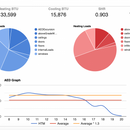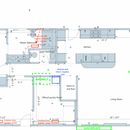Feedback for a 2-zone minisplit plan in Zone 4C
Hi GBA – I’ve been working my way through a medium-depth remodel of a largely uninsulated 1955 house in Seattle, WA, and it’s time to tackle the heating for my main floor. Current heat is from a 60k Btu/hr natural gas furnace blowing through poorly-insulated ductwork in a vented crawlspace. In addition to being more than 3x oversized, the furnace is located in a utility closet that I’d like to convert to a master bathroom. I’ve attached the following:
1. Fuel use analysis from 2/5/2019 – 3/14/2019. This period includes possibly the coldest couple weeks we have had here in a decade. I read my gas meter once in the morning and once in the evening, converted to Btu/hr, and assumed that 5% of my gas was used by my water heater, my furnace was running at its rated 94% efficiency, and 5% of the heat was lost in the ductwork. Conservative assumptions, but enough to show an ‘upper bound’ on my heating needs of around 18k Btu/hr, 15k Btu/hr if I go with a 95% design temperature which is was 33deg F for my location (West Point Lighthouse).
2. Coolcalc results, which show a heating load of 33k Btu/hr. Their number is bananas to start with when compared to my fuel use, but even stranger when considering that the tool didn’t even have options for me to choose “no” insulation in the wall cavities, so it’s using R-13. Not sure it properly captured my uninsulated floor over my vented crawl either, but at this point given the fuel use I think we can disregard coolcalc.
3. Hacky sketchup plans for the post-remodel floorplan, with proposed locations for the high wall unit in the front living/dining room, and a horizontal ducted unit in the crawlspace serving the master bedroom and bathroom, music room, and office.
Summary – I preliminarily am leaning toward a Fujitsu AOU18RLXFZ outdoor unit paired to a ASU9RLF1 wall unit in the great (more like a good) room, and a ARU9RLF hitting the four back rooms.
A couple thoughts:
1. I expect that the community here will have some comments on the wisdom of having the ARU9RLF pushing air into four ducts given that air will flow from the master bedroom to the master bathroom, and from the music room to the office, but until I can get some insulation into these walls I think the heat lost through them by rooms without supply will exceed the heat that comes in from circulation.
2. I’ve got a local guy who does commercial HVAC work during the week and moonlights doing minisplits on the weekends. He can make $500 doing a single zone high wall unit so he turns up his nose at running ductwork for a horizontal-ducted unit, but if I run all the ductwork and the refrigerant lines he’s ok just coming out to charge them and getting everything running properly. Seems like the stuff I’m on the hook for should be within my abilities but I welcome any feedback.
3. I get that part of a Manual J is the room-by-room loads, and I haven’t done that. If I had even relative room-by-room loads I could scale my fuel use to that and get something accurate for sizing the wall unit vs. the horizontal ducted unit, and getting the right airflow to each room on the ducted zone. Given my struggles with coolcalc though I don’t think that such an analysis is within my abilities or my time, and I doubt that hiring someone is within my budget. Maybe I’m putting too much credence in the fuel use, and the reports from this site that most not-egregiously-missized minisplits will modulate pretty well…
4. In addition to insulating the walls, I need to seal up the crawlspace. I know, I’m working on it.
5. The ‘great’ room has a cathedral ceiling that slopes from 18 feet to just under 14 feet in the middle. From what I have seen – looking into an existing range hood exhaust vented through the ceiling, but without taking down drywall – the ceiling is vented and uninsulated cathedral; literally no insulation above the drywall. I’m also starting to see what looks like the effects of condensation on that drywall, on the paint on that drywall, and the hardware that holds that drywall to the rafters. I am working on a plan to fix this too. At this point though it’s all in the budgeting (raising 4 kids in this town is killing me) and sequencing for when drywall comes down and what needs to happen before it goes back up, hopefully to stay. Also, my wife really wants a new kitchen and bathroom, and a lot relies on getting rid of that massive noisy gas unit and getting some minisplits going.
Thoughts? I’m sure I’m leaving some stuff out and that my drawings, fuel use, etc are not industry standard ways of communicating, so thanks in advance to anyone who digs through them. Do I get a Dana stamp of approval, or better yet, advice that saves me from making any major mistakes??
Max
GBA Detail Library
A collection of one thousand construction details organized by climate and house part












Replies
Any thoughts gang? Is my chicken scratch image harder to decode than the rosetta stone? Happy to clarify!
Max,
That Fujitsu ducted unit produces decent pressure, if you are careful with your ducts there is no reason that it won't be about to heat/cool your rooms.
I'm not sure I follow your question, but generally you run a duct to each room from the cassette. You never run a transfer duct from one room to the next to heat/cool it. Return vent is usually best in the hallway with either undercuts in the doors or large transfer ducts through the walls.
For the ducted unit to work well, you'll need to do a room by room load as correctly sizing the ducts is a must.
For DIY ducting, to simplify your life, have an HVAC sheetmetal shop make you the intake and exhaust plenums. Sometimes you can use a return air boot and standard filter box on the inlet side, really depends on where it has to go. The rest is pretty straight forward, I would avoid any flex duct, they are too easy to mess up and end up with a lot of restriction. You want to end up with something resembling this setup:
https://i.ytimg.com/vi/G3E9JBEZ5Zc/hqdefault.jpg
If you seal up your crawlspace, you can put the ducted unit down there along with all the ducts, it would make the install much easier.
My advice is to do a Manual J, S, T & D.
Thanks Akos!
- Re “generally you run a duct to each room from the cassette. You never run a transfer duct.” - agreed. I had been considering more that the door between the bedroom and the bathroom can be left open, and there is no door between the office and the music room. But if the Fujitsu unit can handle the ductwork then I will run ducts to all 4 rooms.
- The image you linked is very helpful, as is the advice to have a sheet metal shop build the supply plenum. I think I should be able to get away with something pretty off the shelf for the return boot and filter box...
- Sounds like I really need to learn how to do room by room loads and do the math in duct sizing from there.
- does matching the overall size of the system (18k BTU/hr) to my fuel use analysis on the coldest days I am likely to see work? It makes intuitive sense to me, just wondering if I’m missing something. Also my loads will drop as I insulate and air-seal, so will this system have a low enough minimum output that it won’t short-cycle if I cut my loads by ~30%
Appreciate all the help!!
Hi GBA community - I'm still in the decision phase on this and would appreciate any thoughts on the below. Many thanks!
- I played around with heat loss assumptions based on my empty walls and uninsulated floors and ceiling, and came up with what I think is a more accurate room-by-room match for indoor equipment: a 12k Btu/hr high-wall unit for the main living room/dining room/kitchen area, and a 7k Btu/hr ducted unit for the master bed & bath, music room, and office.
- I'm considering getting JUST the high-wall unit now, pointing it down the hallway toward the other rooms, and seeing if I can live with leaving doors open and letting the temperature differences fall where they may. I may learn that it's totally fine that way; I may learn that I can get away with it for 355 days/year and put an electric resistance heater in the master bedroom on the 10.25 coldest days, or I may learn that it sucks to not have point-source heat in the back rooms and I need to get the ducted unit. Also the experience in the back rooms may change as I (renovate and) insulate the exterior walls and seal the crawl.
So, given the above plan of getting just the high wall unit now and leaving potential system expansion to the future...
- Can I still go with the AOU18RLXFZ as the outdoor unit and the ASU12RLF as the indoor unit? That would be ideal if I can just bolt on the ARU7RLF later and not have to change anything I put in in round 1, but I'm not sure if the AOU18RLXFZ requires >1 indoor unit to function properly?
Max
>"...I'm not sure if the AOU18RLXFZ requires >1 indoor unit to function properly?"
Most multi-splits require at least 2 zones to be hooked up for it to work at all, and I believe that's the case with the AOU18RLXFZ. I don't know if there is a work-around that lets it run with just one ductless head.
It may be both cheaper and better to install two compressors.
The 12RLS3 puts out a LOT of heat at Seattle type design temps, and not a lot more than the 9RLS3- less than a 10% difference in capacity at +17F, which isn't much incentive for up-sizing it. If the 12RLS3 covers the load with margin, in most cases the 9RLS3 will too.
https://ashp.neep.org/#!/product/25332
https://ashp.neep.org/#!/product/25334
It's probably better and may even be cheaper to go with a 9RLS3 for the wall blob, and later add a 9RLFCD for the ducted zone:
https://ashp.neep.org/#!/product/25310
Well damned if you didn't find about the best sized unit for the load that I can imagine finding!
Max,
You can have a unit outside the bedrooms if you are only heating. In case the bedrooms are a bit too cold, a small panel heater can make up for the shortfall.
If you want cooling though, hallway mount will not work. Your bedrooms will easily be 3C to 5C warmer, which puts in the not pleasant territory.
If you are encapsulating your crawlspace, a single larger ducted cassette installed there can heat/cool your house. Slightly more ductwork, but you won't have to look at a wall mount in your living room. You might be able to re-use the risers for the existing furnace and run a new trunk and return for the mini split.
Thanks Akos!
>"If you want cooling though, hallway mount will not work. Your bedrooms will easily be 3C to 5C warmer, which puts in the not pleasant territory."
Agreed. Fortunately I'm climatically privileged in that regard due to geography :)
>"If you are encapsulating your crawlspace, a single larger ducted cassette installed there can heat/cool your house. Slightly more ductwork, but you won't have to look at a wall mount in your living room. You might be able to re-use the risers for the existing furnace and run a new trunk and return for the mini split."
Yeah, good points. A couple thoughts:
- I don't think we'll settle the old are-high-wall-units-ugly debate here. In this case, my wife doesn't find them unattractive, which is what matters to me. We also tend to see them in newer or recently-renovated houses here, which seems to be broadening their appeal somewhat by association with more expensive cribs.
- This is my second house with floor registers and I have had a dickens of a time keeping furniture off of them. Something about having a family of 6 and choosing to live in small urban spaces I guess. We try, but there are only so many places one can fit a couch, a desk, dining room chairs, etc.
- To the extent I can re-use the registers and the risers from this furnace, I would like to preserve the option of using them for a ventilation system. I got an Awair Glow a few months ago and the speed at which CO2 rises >1000 ppm when I have 3 people in a room is pretty astounding. The summer has been fine because I can keep the windows open, but when we start heating in 3-4 months I'm going to need to either get an HRV/ERV or leave windows cracked and deal with the pain of losing all that heat.
M